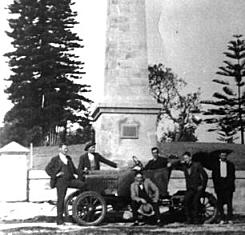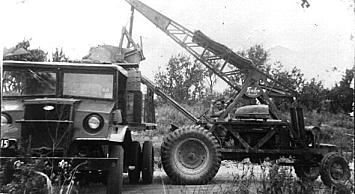 • Ferries & Wharves
• Ferries & Wharves
• Track from Cronulla
• Taxi Services
• On the Buses
• The Road Built
• Lighthouse
• Sea Planes
• Fire Brigade
• Weather Watching
|
Access and Sevices |
Track from Cronulla
Access to Kurnell was a vexed issue for many decades, beginning even before the formation of the Sutherland Shire Council in 1906. From the start, the Council agreed on the need for a road from Cronulla to Kurnell, but no money was allocated. The Trustees of Captain Cook's Landing Place Reserve pushed for such a road in 1910, but without result. In 1920 the State Minister for Works, proposing a National Museum at Kurnell, also urged a start on a road because weather made the La Perouse-Kurnell ferry crossing unreliable, but his government declined to finance it. Kurnell residents, facing stalemate, felt compelled to act. They were fed up with the 'road' they had themselves built, for it was little more than a fair-weather track.
The residents worked to better define their track in an effort to persuade the government to finance and assist with the construction of a permanent carriageway. Councillor Arthur Hand of Sutherland Shire Council organised a group of six men to take the first motor vehicle to Kurnell on 21 st July 1927. Driving a 1919 model Ford which had been converted to a flat tray truck loaded with logs, shovels and chains, the group took two hours to cover the seven miles from Cronulla to Cook's Landing Place. The party included Messrs Bert Saint (the driver), H. Saint, E. G. Vincent, C. Morgan, E. Wells and L. J. Spinks. |
 |
The car bogged and sank several times, often up to its axles in the sand or the swamps, but it was recovered safely on each occasion. At Kurnell the mud-smothered party was welcomed by Messrs Coates, Butterworth, Cox (postmaster), Jones (headmaster of the school) and pupils.
As a result of this adventurous journey, Council furnished details and applied for financial assistance from the State and Commonwealth Governments to construct a road 331 chains long. It offered 3,300 from Council 's slender funds. But the submission was rejected.
In 1929 the Public Works Department offered a loan of 5000 for the road, intending to use unemployed labour to build it. But Council was unable to fund the balance. Then in 1933 Councillor Joe Monro (the man whose single vote had lost Council the 700 acres of sandhills), newly elected to the Legislative Assembly, proposed that the area between Cronulla and Kurnell be established as a Nature Reserve. The Minister for Lands investigated the proposal and suggested that the entire peninsula be a National Park. The road and the National Park schemes were, however, both rejected by the Government. In January 1935 Surveyor Hill surveyed a route for the road from Cronulla to Kurnell; but still it was not built. In 1936 with the 150 th Celebrations approaching, the need for a road to Kurnell became more urgent. Monro, though by then retired from Council, continued to push for a road.
On the 2 nd March 1945, a party of MPs, Council officers and others, on board a tabletop truck, traversed the seven miles of quagmire and sand that lay between Cronulla and Kurnell, where they boarded the La Perouse ferry and returned to Sydney. Unfortunately, their considered opinion was that the construction of the road was a low priority, though the MPs did ask Council to submit a road proposal to the Department of Main Roads and to ask for funding. In 1947 drifting sand studies were done. Council calculated that if it were to resume, subdivide and sell the land between Bate Bay and Kurnell as modern residential blocks, the money from the sale could go towards building the road.
In 1948 Stan Latta set about creating a useable road for his bus to Kurnell. He had formerly worked for T. E. Breen, the sandmining and landfill company, so with the assistance of machinery borrowed from Breen and with ashes from the Breen landfill stockpile Latta, together with George Blundell and other Kurnell residents, laid a fairly solid road bed through a stretch of swamp and sand. |

 |
| On 30th April 1949, for the nation's 150th Celebrations, 500 visitors came to Kurnell by boat and by ferry from La Perouse. During the crossing the wind rose and the rains teemed down. The wind, indeed, was gauged at above 60 mph. The Governor could not get within a mile of the site. Arrival by ferry was impossible. He was obliged to return to La Perousebut the ceremonies went on without him! At the conclusion of the festivities Kurnell was left with over 500 visitors who could not get home. Residents, however, rose to the occasion, fed them, and offered accommodation. Locals shuttled some visitors by truck (which they had adapted to their sandy track) to Cronulla, cheerfully interrupting the arduous journey to rescue and recover RAAF trucks that had become bogged while coming to the rescue of the stranded visitors. |
| top of page |
|



